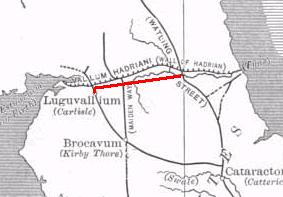Stanegate
| Stanegate | |
|---|---|

Route of the Stanegate
|
|
| Route information | |
| Length: | 38 mi (61 km) |
| Time period: | Roman Britain |
| Major junctions | |
| From: | Corstopitum |
| Vindolanda, Magnis | |
| To: | Luguvalium |
The Stanegate, or "stone road" (Old Norse), was an important Roman road built in what is now northern England. It linked two forts that guarded important river crossings; Corstopitum (Corbridge) in the east, situated on Dere Street, and Luguvalium (Carlisle) in the west. The Stanegate ran through the natural gap formed by the valleys of the Tyne and Irthing. It predated Hadrian's Wall by several decades; the Wall would later follow a similar route, slightly to the north.
The Stanegate differed from most other Roman roads in that it often followed the easiest gradients, and so tended to weave around, whereas typical Roman roads follow a straight path, even if this sometimes involves having punishing gradients to climb.
It is believed that the Stanegate was probably built under the governorship of Agricola. It is also thought that it was built as a strategic road when the northern frontier was on the line of the Forth and Clyde, and only later became part of the frontier when the Romans withdrew from what is now Scotland. An indication of this is that it was provided with forts at one-day marching intervals (14 Roman miles or modern 13 miles (21 km)), sufficient for a strategic non-frontier road. The forts at Vindolanda (Chesterholm) and Nether Denton have been shown to date from about the same time as Corstopitum and Luguvalium, in the 70s AD and 80s AD. When the Romans decided to withdraw from Scotland, the line of the Stanegate became the new frontier and it became necessary to provide forts at half-day marching intervals. These additional forts were Newbrough, Magnis and Brampton Old Church. It has been suggested that a series of smaller forts were built in between the 'half-day-march' forts. Haltwhistle Burn and Throp might be such forts, but there is insufficient evidence to confirm a series of such fortlets. The retreat from Scotland took place in about 105 AD, and so the strengthening of the Stanegate defences would date from about that time.
...
Wikipedia
